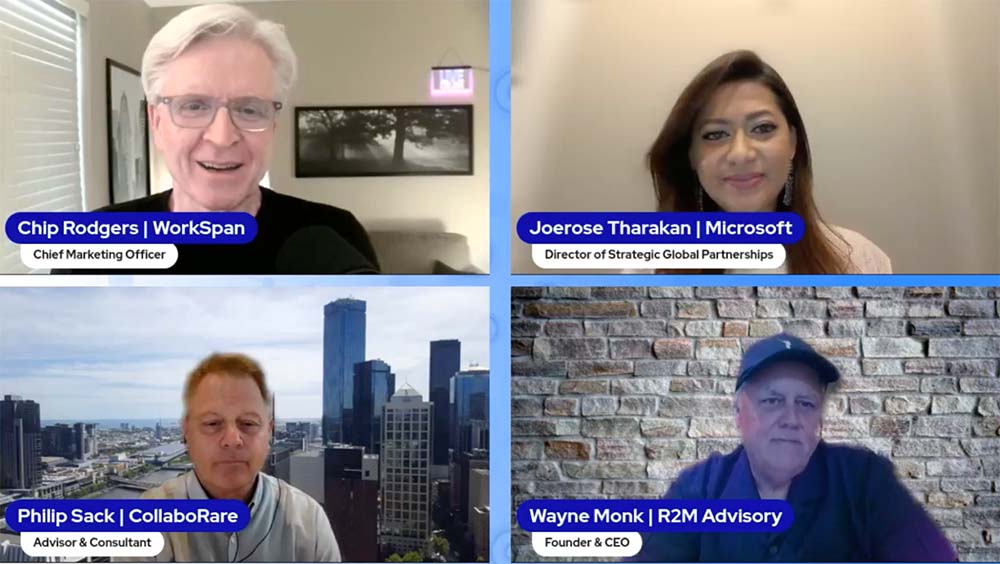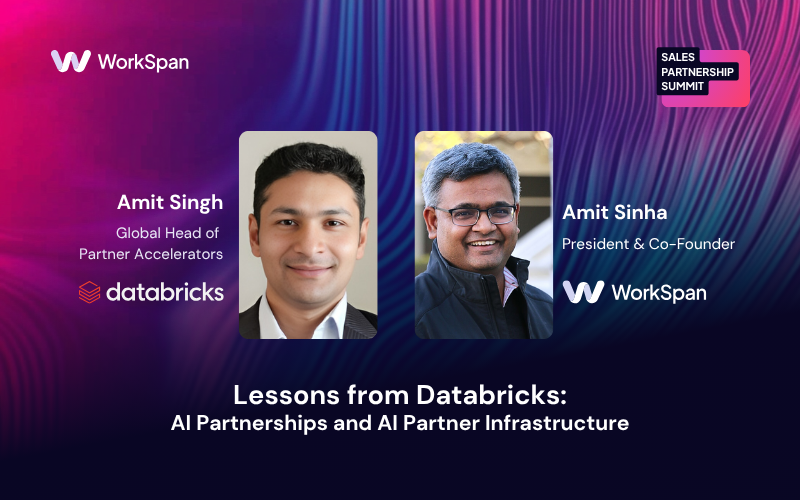
Partner programs are increasingly being used by organizations as a business strategy to expand their customer base and increase sales. The impact of partners on a business can be significant, ranging from driving sales to enhancing market share, innovation, and brand recognition. To maximize the benefits of a partner program, it is crucial for companies to have a comprehensive understanding of the opportunities it provides. We've brought together an expert panel of ecosystem professionals to discuss "Partner Program Best Practices". Read on to learn more about our expert panel's advice and thoughts on how to run a successful partner program.
Our panelists:
- Joerose Tharakan, Director of Partner Development-Strategic Global Partnerships, Microsoft
- Philip Sack, Advisor & Consultant, CollaboRare
- Wayne H. Monk, Founder & CEO R2M Advisory
Let’s get into the conversation!

Key Metrics to evaluate Partner Programs
When it comes to evaluating the success of partner programs, it's important to keep both efficiency and effectiveness in mind. In other words, you need to consider not only how well the program is performing in terms of revenue and share, but also how efficiently it's leveraging resources, processes, and capabilities.
To evaluate the effectiveness of a partner program, revenue contribution and partner contribution are often considered the North Star metrics. However, it's important to dig deeper and measure activities such as deal registrations, net new partner opportunities, offering development, pipeline, and revenue generated. It's also important to measure engagement between direct sales and partners, as well as the consumption of enablement, marketing campaigns, and services attach.
Additionally, it's important to tailor metrics to the business goals and maturity of the program, as well as to understand the partner success criteria. By doing so, you can gain insights into their business models and what's important to them, and then align the program accordingly.
Audience Question: “How long do you stick with a partner when they're not delivering on a scorecard metric?”[Ruben Alcaraz - Nestle Purina]
In a partnership, it is important to establish specific goals and objectives, and to regularly assess whether the partner is taking actions and demonstrating behaviors that are aligned with those goals. If the partner is not meeting the goals, the conversation should be about drilling down into the problem and addressing it, rather than simply terminating the partnership. Partnerships that involve difficult discussions that are successfully addressed and resolved tend to be the most successful.
Another important thing is portfolio management and partners should understand where they sit in their portfolio and what investments they will make. Competitive perspective, defined value, and timing should also be considered, and a scorecard can be used to facilitate an open dialogue between partners.
Rather than simply terminating a partnership due to non-performance, the panelists unanimously suggest that partnerships should be two-way relationships and that both parties should be involved in partnership reviews. Partners should assess the purpose of the partnership and if the initial criteria are no longer applicable, they should explore new opportunities for value creation.
What are good tactics to keep partners engaged with your partner program?
Is it important to design incentives for partners in a partner program to encourage them to prioritize your program over other competing priorities. According to the panelists, it is crucial to incentivize partners to engage them in the right behavior that will drive their participation in the program. This incentive should be tailored to what is important to the partner, such as driving profitability or helping them build a vibrant funnel.
A few tips by ecosystem pros to keep your partners engaged and invested in your business.
- Help your partners win business: By helping your partners build their funnel, co-selling with them, and enabling them to win, you can keep them engaged and invested in your business.
- Focus on program benefits: Make sure your partner program benefits are in the right place, so your partners can be profitable. Consider factors such as incentives, ease of doing business, and complementary solutions.
- Be transparent and honest: Treat your partners like employees, and be open and honest with them. Avoid telling them what you think they want to hear and instead be direct.
- Include them in everything: Expose your partners to your company's marketing strategy, sales execution plans, service teams, and leadership. Create advisory boards and roles for them to participate in and include them in your company culture.
- Be predictable and fair: Avoid changing your partner program without communicating the changes to your partners. Help them navigate their business and be transparent about how they can make money.
In addition to the above there are three macro-level thoughts to keep partners engaged. The first is recognition and celebrating success to create poster children and promote genuine transparency. The second is building social and relationship capital through governance, regular meetings, and scorecards. The third is making the engagement program partner-friendly by simplifying the experience and investing in resources and training. It is important to have an outside lens looking in to compete with others and become a better organization to deal with.
How are programs customized based on partner types? (ISVs, GSIs, Hardware, MSPs, etc.
Customized programs are crucial to maintaining successful partnerships that deliver value and promote growth. Programs are customized based on partner types to ensure efficiency and deliver value to both parties.
The first step is to identify the partner's value proposition and where they fit in the partnership relationship. This can be achieved by either categorizing partners based on their primary area of expertise or giving them the option to elect into specific programs based on their qualification criteria. It is essential to balance the need for flexibility and consistency to avoid overwhelming partners with too many options.
The panel all pointed out that it’s no longer possible to neatly fit partners into specific “types” of partners. GSIs are creating software IP, reseller partners are offering services, and some partners offer an array of software, services, cloud services, etc. So customizations need to be focused on partner capabilities rather than strictly defining partners by type.
As partnerships mature, both parties develop a better understanding of each other's business models and can direct each other with a set point of view on where to partner and which programs to enroll in.
Why is internal and executive buy-in essential to creating an engaged partner program?
Partner programs are a complex function in the technology industry. From recruiting and enabling partners to building pipelines and creating go-to-market strategies, the success of a partner program requires a cross-functional effort from every department within an organization. However, one critical factor that is often overlooked is the importance of executive buy-in.
Without executive buy-in, partner leaders may struggle to build and scale successful, vibrant, and scalable partner programs. An executive who understands the complexities of building a partner program is essential. They must understand the time and effort it takes to recruit, enable, and build a pipeline with partners. Without this understanding, the program is likely to fail or not scale as fast as desired.
Moreover, an executive needs to ensure that stakeholders from every function within the organization are committed to partnering. They should also delegate a dedicated resource to the partner program and not have it report low into the organization.Creating a culture of partnerships is critical to the success of the program. This means having a champion who understands the value of partnerships and can help sponsor the program. Having a chief alliances officer or chief partner officer can help drive this culture and ensure that partnerships are core to the organization's culture.
Where does technology play a role in managing a partner program?
Partnerships are critical for scaling a business, but they can be complex to manage. One of the key challenges is ensuring that partners can easily interact with your company and each other, which requires a technology interface that acts as the front door to your partnership. This platform is where partners report their metrics, share account lists, co-sell, and access other essential functions.
However, designing and implementing a partnership platform can be challenging, as it often requires shoehorning into an existing technology stack or building from scratch. That's where companies like WorkSpan come in, providing solutions that enable partner interoperability and streamline partner management.
A single partnership platform can help manage deal registrations, account mapping, lead sharing, offering management, enablement, and even payments. By automating these processes, companies can focus on building strong partnerships and scaling their business.
While implementing a partnership platform can be challenging, the benefits are clear. Companies that use these solutions can easily accommodate high volumes of deal registrations and account mapping, share customer lists automatically, co-sell, and more. The platform also enables partners to experiment, innovate, and collaborate, which can lead to increased revenue and long-term success. Overall, a partnership platform is essential for scaling a business and building strong partnerships in today's ecosystem-driven world.
Conclusion
Building and managing successful partner programs is crucial for scaling a business, but it requires a cross-functional effort from every department within an organization. It's essential to set clear goals and objectives, regularly assess partner activities and behaviors, and tailor metrics to business goals and partner success criteria.
Links & Resources
- Learn more about how WorkSpan helps customers accelerate their ecosystem flywheel through Co-selling, Co-innovating, Co-investing, and Co-marketing.
- Subscribe to the Ecosystem Aces Podcast on Apple Podcast, Spotify, Stitcher, and Google Podcast.
- Find insightful articles on leading and getting the most out of your partner ecosystem on the WorkSpan blog.
- Download the Best Practices Guide for Ecosystem Business Management
- Download the Ultimate Guide for Partner Incentives and Market Development Funds
- To contact the host, Chip Rodgers, with topic ideas, suggest a guest, or join the conversation about modern partnering, he can be reached on Twitter, LinkedIn, or send Chip an email at: chip@workspan.com
Heading
Heading 1
Heading 2
Heading 3
Heading 4
Heading 5
Heading 6
Lorem ipsum dolor sit amet, consectetur adipiscing elit, sed do eiusmod tempor incididunt ut labore et dolore magna aliqua. Ut enim ad minim veniam, quis nostrud exercitation ullamco laboris nisi ut aliquip ex ea commodo consequat. Duis aute irure dolor in reprehenderit in voluptate velit esse cillum dolore eu fugiat nulla pariatur.
Block quote
Ordered list
- Item 1
- Item 2
- Item 3
Unordered list
- Item A
- Item B
- Item C
Bold text
Emphasis
Superscript
Subscript





.png)